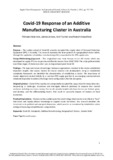- CERES Home
- →
- School of Management (SoM)
- →
- Staff publications (SoM)
- →
- View Item
JavaScript is disabled for your browser. Some features of this site may not work without it.
| dc.contributor.author | Boehme, Tillmann | |
| dc.contributor.author | Aitken, James | |
| dc.contributor.author | Turner, Neil | |
| dc.contributor.author | Handfield, Robert B. | |
| dc.date.accessioned | 2021-07-21T10:42:06Z | |
| dc.date.available | 2021-07-21T10:42:06Z | |
| dc.date.issued | 2021-07-22 | |
| dc.identifier.citation | Boehme T, Aitken J, Turner N, Handfield R. (2021) Covid-19 response of an additive manufacturing cluster in Australia. Supply Chain Management: An International Journal, Volume 26, Number 6, September 2021, pp. 767-784 | en_UK |
| dc.identifier.issn | 1359-8546 | |
| dc.identifier.uri | https://doi.org/10.1108/SCM-07-2020-0350 | |
| dc.identifier.uri | http://dspace.lib.cranfield.ac.uk/handle/1826/16905 | |
| dc.description.abstract | Purpose The sudden arrival of Covid-19 severely disrupted the supply chain of personal protective equipment (PPE) in Australia. This paper aims to examine the development of a geographical cluster, which, through the application of additive manufacturing (AM), responded to the PPE supply crisis. Design/methodology/approach This longitudinal case study focuses on an AM cluster, which was developed to supply PPE in a responsive and flexible manner from 2019/2020. The study gathered data over three stages of cluster evolution: pre, during and post-peak Covid-19. Findings The type and nature of exchanges between organizations involved in the cluster established important insights into success factors for cluster creation and development. Using an established complexity framework, this study identifies the characteristics of establishing a cluster. The importance of cluster alignment created initially by a common PPE supply goal led to an emerging commercial and relational imperative to address the longer-term configuration after the disruption. Practical implications Clusters can be a viable option for a technology-driven sector when there is a “buzz” that drives and rapidly diffuses knowledge to support cluster formation. This research identifies the structural, socio-political and emergent dimensions, which need to be considered by stakeholders when aiming at improving competitiveness using clusters. Originality/value Covid-19 has rapidly and unexpectedly disrupted the supply chain for many industries. Responding to challenges, businesses will investigate different pathways to improve the overall resilience including on-/near-shoring. The results provide insights into how clusters are formed, grow and develop and the differentiating factors that result in successful impacts of clusters on local economies. | en_UK |
| dc.language.iso | en | en_UK |
| dc.publisher | Emerald | en_UK |
| dc.rights | Attribution-NonCommercial 4.0 International | * |
| dc.rights.uri | http://creativecommons.org/licenses/by-nc/4.0/ | * |
| dc.subject | complexity | en_UK |
| dc.subject | cluster analysis | en_UK |
| dc.subject | disaster relief | en_UK |
| dc.subject | supply chain vulnerability | en_UK |
| dc.subject | supply chain disruptions | en_UK |
| dc.subject | agile systems | en_UK |
| dc.title | Covid-19 response of an additive manufacturing cluster in Australia | en_UK |
| dc.type | Article | en_UK |
Files in this item
The following license files are associated with this item:
This item appears in the following Collection(s)
-
Staff publications (SoM) [1270]

